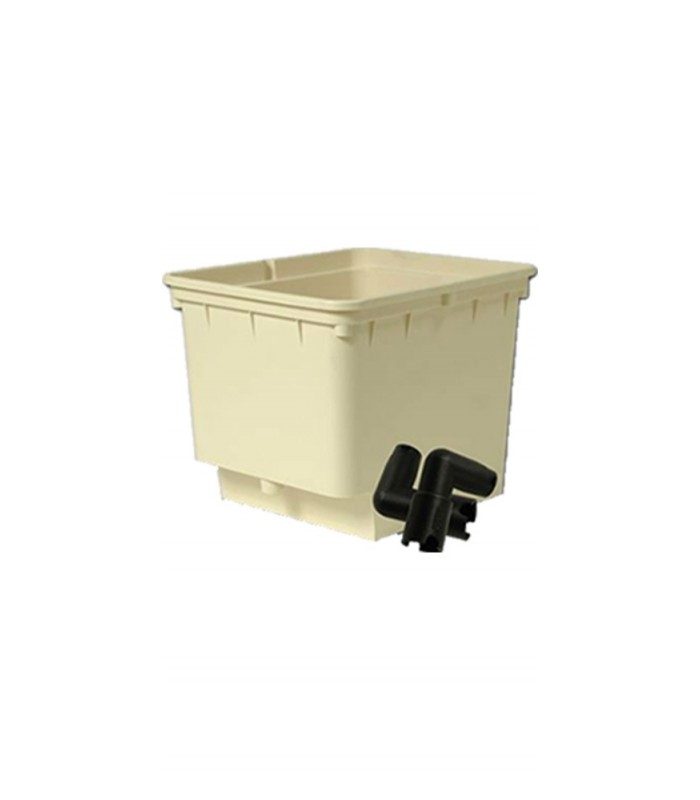

Una temperatura dell’acqua compresa tra i 18 e 22 gradi aiuta a mantenere buoni livelli di ossigeno disciolto (DO) ed evita il proliferare di batteri anaerobi responsabili di malattie e marciumi radicali. E’ buona norma (quando possibile) interrare la vasca di raccolta per preservare la soluzione dal riscaldamento, cosa molto comune quando si coltiva in serra durante i periodi estivi. In oltre la vasca di raccolta dovrà essere dotata di coperchio e schermata dai raggi luminosi per evitare la conseguente formazione di alghe. If greater autonomy is desired, the reservoir capacity must be increased or an automatic refilling system must be inserted (see floating valve). The tank must have a volume of 48 liters + a reserve of at least another 150 liters to guarantee an autonomy of about 4 days. Taking into account that the Dutch vase holds about 2 liters of water on the bottom before reaching the level necessary for drainage, the tank must have an adequate volume to contain sufficient water.Įach jar contains 2 liters of water therefore 24 x 2 = 48 liters When sizing the tank, it will be necessary to take into account the number of jars to be fed. When preparing the drain line, a slight slope must be provided in order to facilitate the flow of the drainage solution towards the tank.

There are also types of PVC pipes with a sort of glass with a gasket that allows the fitting of fittings and extensions without the use of glue. PVC pipes require dedicated fittings which must be mounted with the help of a special PVC glue. It consists of a 50mm diameter PVC tube, along which 26mm holes are drilled for inserting the vessel drain. The drain line has the function of collecting the drainage solution from the vessels and returning it to the tank. Rubber pipe fittings D 16MM (tee, elbow, plug, valves).Solution distribution line in multilayer PE pipe PN4 (white / black) diameter 16 mm.Drain / drain line consisting of 50mm PVC pipe.To build a Dutch Buckets system you need to:
#Bato bucket how to#
HOW TO CREATE A HYDROPONIC SYSTEM WITH DUTCH BUCKETS

The excess solution will be drained along the drain hose back to the main tank. The Dutch pot is a plastic pot, available in volumes of 10 or 12 liters, with a particular shape that allows it to be positioned along a 50mm PVC drain pipe which collects the drainage of the solution and conveys it to the collection tank of the solution.Ī pump will push the nutrient solution from the tank or reservoir, this will be distributed through a drop system directly into the respective vessels, bringing water and nourishment to the roots of the plants. Plants grown with this system grow with roots in a substrate consisting mainly of expanded clay or perlite or a mixture of the two. Each bucket can be set up separately, allowing growers to space out larger crops (like tomatoes or eggplants) without wasting media.The hydroponic cultivation systems with Dutch Buckets, have been used for many years for the production of vegetables both in large commercial greenhouses and for domestic use.Ī hydroponic system with Dutch vases lends itself particularly well to customizations and can be adapted to any type of environment. Add the Hydroponic nutrients at suggested amounts bottle by bottle.ĭutch buckets as “fragmented media beds” A variation of media bed techniques, Dutch buckets break the media bed system down into smaller components (the buckets).Fill the reservoir with water (distilled, or tap water is fine as long as it is not contaminated).Drill/cut the lid, creating a hole large enough to place and hold a net pot.Subsequently, question is, how do you start Kratky method? How to set up a Kratky system It functions to drain the excess nutrient solutions to the return line and then come back to the reservoir. You will also see the bucket elbow at each bucket. The drip emitters are fixed to the irrigation line and are pointed to each bucket to feed the plants. Bato buckets have seen extensive use throughout Europe and the US, and can be connected easily, allowing hydroponic systems to be scaled to virtually any size needed. Also called a Dutch bucket, the Bato bucket is perhaps the most commonly used container for holding plants in an indoor growing system.


 0 kommentar(er)
0 kommentar(er)
